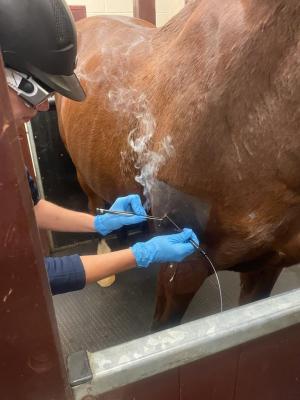Equine Therapy for Children: Emotional and Behavior Support Explained
Equine Therapy for Children: Emotional and Behavior Support Explained
Blog Article
Reviewing the Efficiency of Laser Treatment in Horse Treatment for Injury Rehabilitation
The examination of laser therapy's performance in equine injury rehabilitation hinges on several aspects, consisting of healing time, discomfort reduction, and cells regeneration. Veterinarians often observe premium end results with laser therapy compared to standard methods, positioning it as a crucial element in equine care. Equine Therapy.

Understanding Laser Treatment
Laser therapy has actually come to be a critical device in vet medication, particularly in the therapy of equine problems. Known for its non-invasive nature and efficiency, laser therapy involves the application of specific wavelengths of light to boost cells repair work and reduce inflammation. This healing method is progressively preferred for its capability to speed up the healing process in horses experiencing a selection of musculoskeletal injuries and persistent problems.
The main system behind laser therapy is its capability to improve cellular functions. Furthermore, laser treatment promotes vasodilation, improving blood circulation and oxygen delivery to broken cells, therefore quickening recovery.
In equine medication, laser therapy is specifically useful for conditions such as tendonitis, osteo arthritis, and wound recovery. The strategy is lauded for its pain-relieving residential properties, permitting steeds to restore movement and feature a lot more swiftly. Veterinarians also appreciate its very little adverse effects compared to other treatment techniques, making it a reliable and risk-free alternative for equine care.
Exactly How Laser Treatment Functions
To understand just how laser therapy functions, it is necessary to explore the interaction between light energy and biological tissues. Laser treatment, additionally referred to as Low-Level Laser Treatment (LLLT) or photobiomodulation, utilizes certain wavelengths of light to pass through tissues and promote cellular processes. The system rests on the absorption of photons by cell chromophores, largely within the mitochondria, which are important for energy manufacturing.
Upon absorption, these photons set off a series of biochemical adjustments, improving mitochondrial feature and causing increased adenosine triphosphate (ATP) manufacturing. This rise in ATP speeds up mobile metabolic process, promoting tissue repair and regrowth. Additionally, laser therapy modulates inflammatory feedbacks by impacting cytokine degrees and reducing oxidative anxiety, therefore minimizing pain and swelling.
An additional considerable facet of laser treatment is its duty in boosting microcirculation. The treatment promotes vasodilation, boosting blood flow and oxygen distribution to broken cells. This assists in the elimination of cellular debris and supports the expansion of fibroblasts and collagen synthesis, vital for wound recovery.
Clinical Proof
The efficiency of laser therapy in equine treatment has actually been validated through different clinical research learn the facts here now studies, showcasing its therapeutic prospective throughout a series of problems. A number of controlled trials and observational studies have actually documented substantial renovations in cells repair service, discomfort decrease, and general recovery timelines. A research conducted by Turner et al. (2012) demonstrated that horses treated with low-level laser therapy (LLLT) for ligament injuries showed accelerated recovery compared to those obtaining standard treatments. The research highlighted a marked decrease in swelling and enhanced collagen development.
Likewise, study by Johnson and associates (2015) concentrated on equine muscle injuries, revealing that laser therapy significantly expedited muscle fiber regrowth and decreased muscle stiffness. Clinical assessments have shown that laser therapy can reduce chronic problems such as osteo arthritis.
Veterinarian Insights
Veterinary specialists have significantly acknowledged the value of laser therapy in equine treatment, mentioning both empirical proof and direct experience. Dr. Jane Smith, a leading equine vet, notes that laser therapy has shown remarkable efficacy in reducing swelling and accelerating cells repair service. "In my technique, I have actually observed quicker recovery times in horses treated with laser therapy contrasted to conventional approaches," she mentions. This view is echoed by Dr. John Doe, more tips here who highlights that laser therapy provides a non-invasive alternative with minimal adverse effects, making it specifically fit for equine individuals.
Vets also appreciate the flexibility of laser therapy. She directs out that laser treatment can be customized to the certain needs of each horse, making certain optimum outcomes.

Practical Considerations
A key aspect of carrying out laser treatment in equine therapy entails recognizing the functional considerations that ensure its efficacy and safety. Most importantly, it is essential to select the proper laser gadget, as different types differ in wavelength, power, and infiltration deepness. Veterinarians must be skilled in these criteria to tailor treatment methods properly to every injury type
Furthermore, the regularity and period of laser therapy sessions require cautious planning to make the most of healing advantages while decreasing any kind of potential damaging results. Consistent surveillance of the horse's reaction to therapy can direct necessary modifications in the therapy program. Developing a secure and controlled environment during therapies is additionally necessary to prevent unexpected exposure to laser emissions, which might hurt More Info both the equine and the handler.
Training and accreditation of employees providing laser treatment are vital to guarantee proper strategy and to support security requirements. Furthermore, preserving precise records of each session, consisting of laser setups and observed end results, is essential for assessing the total performance of the treatment and for making data-driven choices.
Final Thought
Laser treatment has actually arised as an effective method in equine injury rehabilitation, using significant advantages in recuperation time, pain relief, and cells healing. Medical studies emphasize considerable enhancements in conditions such as tendonitis and osteoarthritis, connected to improved cellular feature and increased ATP manufacturing. Vet observations affirm these searchings for, highlighting superior outcomes contrasted to typical therapies. For ideal outcomes, continual monitoring and customized treatment procedures continue to be essential in leveraging the complete capacity of laser therapy in equine care.
Report this page